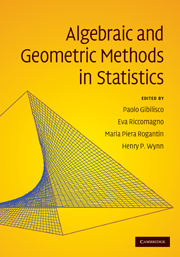Book contents
- Frontmatter
- Contents
- List of contributors
- Preface
- Frequently used notations and symbols
- 1 Algebraic and geometric methods in statistics
- Part I Contingency tables
- 2 Maximum likelihood estimation in latent class models for contingency table data
- 3 Algebraic geometry of 2×2 contingency tables
- 4 Model selection for contingency tables with algebraic statistics
- 5 Markov chains, quotient ideals and connectivity with positive margins
- 6 Algebraic modelling of category distinguishability
- 7 The algebraic complexity of maximum likelihood estimation for bivariate missing data
- 8 The generalised shuttle algorithm
- Part II Designed experiments
- Part III Information geometry
- Part IV Information geometry and algebraic statistics
- Part V On-line supplements
3 - Algebraic geometry of 2×2 contingency tables
from Part I - Contingency tables
Published online by Cambridge University Press: 27 May 2010
- Frontmatter
- Contents
- List of contributors
- Preface
- Frequently used notations and symbols
- 1 Algebraic and geometric methods in statistics
- Part I Contingency tables
- 2 Maximum likelihood estimation in latent class models for contingency table data
- 3 Algebraic geometry of 2×2 contingency tables
- 4 Model selection for contingency tables with algebraic statistics
- 5 Markov chains, quotient ideals and connectivity with positive margins
- 6 Algebraic modelling of category distinguishability
- 7 The algebraic complexity of maximum likelihood estimation for bivariate missing data
- 8 The generalised shuttle algorithm
- Part II Designed experiments
- Part III Information geometry
- Part IV Information geometry and algebraic statistics
- Part V On-line supplements
Summary
Abstract
Contingency tables represent the joint distribution of categorical variables. In this chapter we use modern algebraic geometry to update the geometric representation of 2 × 2 contingency tables first explored in (Fienberg 1968) and (Fienberg and Gilbert 1970). Then we use this geometry for a series of new ends including various characterizations of the joint distribution in terms of combinations of margins, conditionals, and odds ratios. We also consider incomplete characterisations of the joint distribution and the link to latent class models and to the phenomenon known as Simpson's paradox. Many of the ideas explored here generalise rather naturally to I × J and higher-way tables. We end with a brief discussion of generalisations and open problems.
Introduction
(Pearson 1956) in his presidential address to the Royal Statistical Society was one of the earliest statistical authors towrite explicitly about the role of geometric thinking for the theory of statistics, although many authors previously, such as (Edgeworth 1914) and (Fisher 1921), had relied heuristically upon geometric characterisations.
For contingency tables, beginning with (Fienberg 1968) and (Fienberg and Gilbert 1970), several authors have exploited the geometric representation of contingency table models, in terms of quantities such as margins and odds ratios, both for the proof of statistical results and to gain deeper understanding of models used for contingency table representation. For example, see (Fienberg 1970) for the convergence of iterative proportional fitting procedure, (Diaconis 1977) for the geometric representation of exchangeability, and (Kenett 1983) for uses in exploratory data analysis.
Information
- Type
- Chapter
- Information
- Algebraic and Geometric Methods in Statistics , pp. 63 - 82Publisher: Cambridge University PressPrint publication year: 2009
Accessibility standard: Unknown
Why this information is here
This section outlines the accessibility features of this content - including support for screen readers, full keyboard navigation and high-contrast display options. This may not be relevant for you.Accessibility Information
- 4
- Cited by
